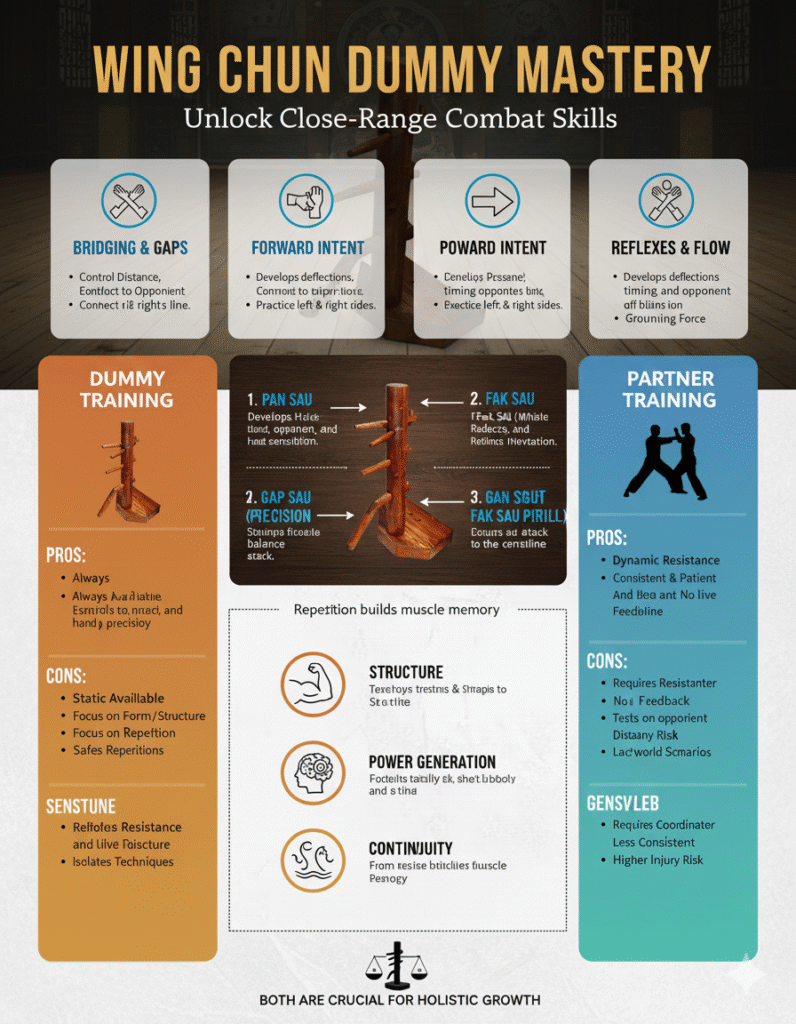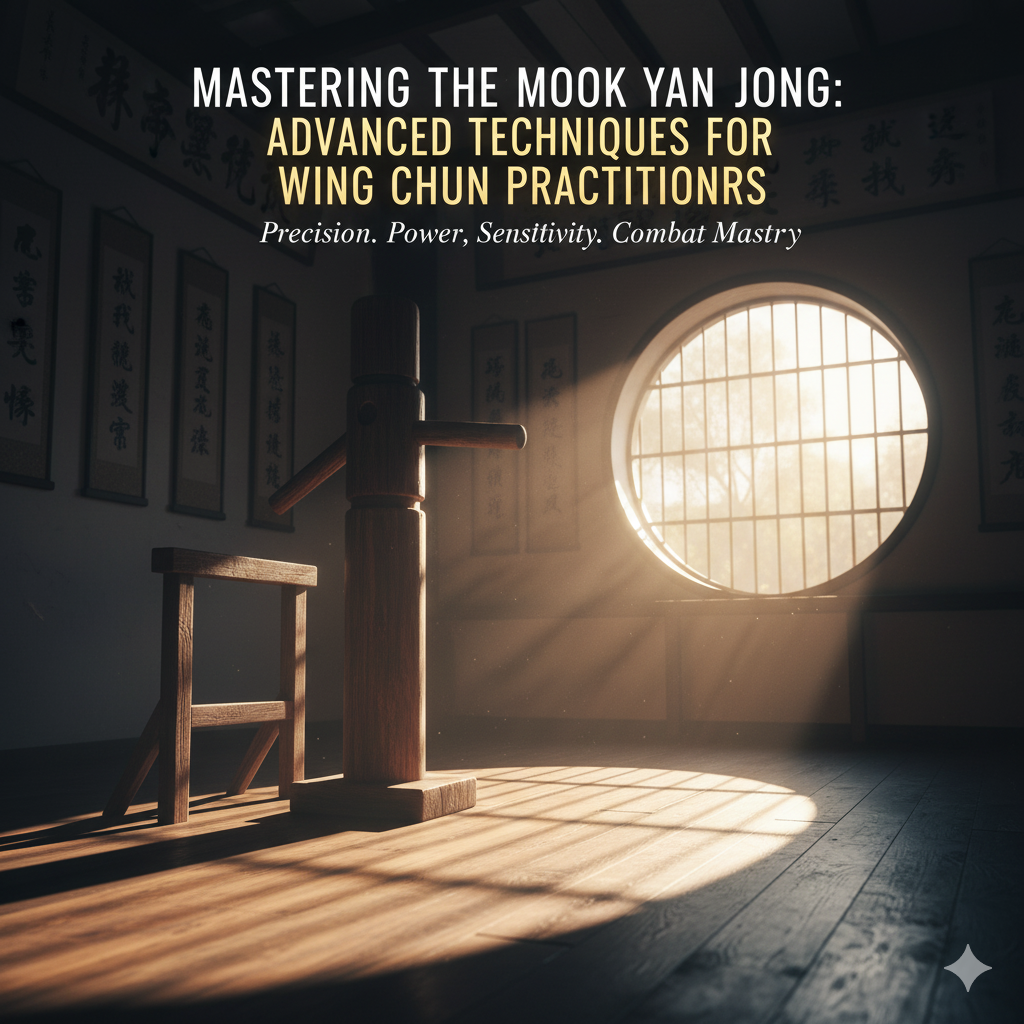The Wing Chun dummy training, or Mook Yan Jong, is one of the most recognizable symbols of this elegant and efficient martial art.
It’s more than just a wooden post with arms and a leg; it’s a sophisticated training partner that, when understood and utilized correctly, can transform a practitioner’s skill.
For many, the dummy is a tool for conditioning and practicing the 108-movement form.
However, its true value lies in its ability to teach the subtle and crucial concepts of bridging and entry – the very heart of Wing Chun combat.
This post will delve into how the Wing Chun dummy is not just a static piece of equipment but a dynamic tool for mastering the art of bridging and entry.
We will explore the fundamental principles, specific techniques, and training methods that can help you unlock the full potential of your Mook Yan Jong practice.

Understanding the Wing Chun Dummy: Your Silent Sifu
Before we dive into the intricacies of bridging and entry, let’s briefly revisit what makes the Wing Chun dummy so special.
Known as the Muk Yan Jong, this wooden apparatus is meticulously crafted to simulate an opponent’s limbs and torso [1].
Typically made from durable hardwoods like teak or oak, it features a cylindrical body, three arms positioned at various angles and heights, and a single leg [1].
These elements are not arbitrary; they represent the crucial points of contact and attack in a real confrontation.
The dummy is usually mounted on a frame that allows for slight movement, mimicking the dynamic nature of an actual opponent [1].
This subtle give and take is vital for developing a sense of flow and adaptability, preventing practitioners from becoming rigid in their movements.
It’s a tool designed to help you internalize the principles of Wing Chun, transforming theoretical knowledge into practical, reflexive skill.
The Essence of Bridging in Wing Chun
In Wing Chun, a “bridge” refers to the connection established between a practitioner and their opponent, typically through the forearms [2].
This connection is not merely physical; it’s an energetic pathway that allows the Wing Chun practitioner to feel, control, and ultimately occupy the opponent’s centerline.
The goal is to get to the opponent’s center, and the bridge is the means to that destination [2].

The wooden dummy plays a pivotal role in understanding and developing this concept.
The dummy’s arms represent the opponent’s energy pathways.
When training, the objective is not to crash into these arms but to deflect and slide along them, maintaining constant contact while simultaneously attacking and defending [2].
This teaches the practitioner to manage force, redirect energy, and create openings without disengaging from the opponent.
Benefits of training bridging on the dummy include developing tactile awareness, allowing the practitioner to feel the opponent’s movements and intentions [2].
This sensitivity is crucial for close-quarter combat, enabling efficient and precise responses.
However, it’s vital to remember that the bridge is a means to an end, not the end itself.
As Sifu Adam Williss emphasizes, practitioners must avoid chasing hands and instead focus on the ultimate goal: occupying the opponent’s centerline.
The maxim, “If there is no bridge, create one,” highlights the proactive nature of Wing Chun, where the practitioner moves towards the opponent’s center, thereby establishing the bridge [2].
Entry Techniques: Closing the Distance with Precision
Once a bridge is established, the next critical phase in Wing Chun combat is the entry.
Entry techniques are about closing the distance safely and effectively, transitioning from the initial contact to a dominant position where strikes can be delivered with maximum impact.
The Wing Chun dummy is an unparalleled tool for refining these crucial movements.
The dummy allows practitioners to drill various entry scenarios without the unpredictability of a live partner.
This controlled environment is ideal for developing muscle memory and understanding the precise angles and footwork required.
For instance, practicing a cross-hand bridging method on the dummy involves a sequence of movements:
a cross-hand jab, transitioning into Laap Sao (grabbing hand), then Huen Sao (circling hands), and finally Taan Sao* (spreading hand) [3].
This fluid progression, combined with precise footwork, allows the practitioner to enter and control the opponent’s space.

Key aspects of entry training on the dummy include:
Footwork and Positioning: The dummy forces practitioners to move efficiently, using angles to their advantage to gain a superior position.
Drills focus on shuffle steps and precise adjustments to maintain balance and stability while advancing [1, 3].
Simultaneous Attack and Defense: Wing Chun emphasizes simultaneous blocking and striking.
The dummy’s arms provide targets for both defensive deflections and offensive strikes, training the practitioner to execute both actions concurrently during an entry [1].
Developing Structure and Power: The solid nature of the dummy helps in developing proper body structure, ensuring that power is generated from the ground up and channeled effectively through the limbs.
Repeated impact conditions the forearms and hands, preparing them for real-world application [1].
Flow and Adaptability: While the dummy is static, the practitioner’s interaction with it should be fluid.
The slight movement of the mounted dummy encourages adaptability, teaching the practitioner to adjust their movements based on the simulated resistance, much like responding to a live opponent [1].

Specific Drills and Applications on the Mook Yan Jong
Training with the Wing Chun dummy is not about mindless repetition;
it’s about understanding the underlying principles and applying them through specific drills.
Here are some key drills that focus on bridging and entry:
1. Basic Bridging Drills: Start by gently making contact with the dummy’s arms.
Practice Pak Sao (slapping hand) and Tan Sao* (dispersing hand) movements, focusing on maintaining light, sensitive contact while moving forward.
The goal is to feel the dummy’s resistance and redirect it, rather than clashing with it.
This builds the tactile sensitivity needed for effective bridging.
2. Centerline Entry Drills: From a bridging position, practice advancing towards the dummy’s center.
This involves precise footwork, such as the Bi Ma (thrusting step) or Juen Ma (turning step), combined with simultaneous hand techniques like Gan Sao (cutting hand) or Bong Sao (wing arm) to clear the dummy’s arms and access its body.
The dummy’s fixed structure provides immediate feedback on whether your entry is direct and efficient.
3. Cross-Hand Bridging and Entry: As mentioned earlier, this drill involves initiating contact with a cross-hand jab, then flowing through Laap Sao, Huen Sao, and Taan Sao to control the dummy’s arm and create an opening for a strike [3].
This sequence teaches seamless transitions from initial contact to a dominant attacking position.
4. Deflection and Counter-Attack Drills: The dummy is excellent for practicing deflecting incoming force and immediately countering.
For example, if the dummy’s arm represents an incoming strike, practice deflecting it with a Fook Sao (controlling hand) or Jut Sao (jerking hand) while simultaneously delivering a punch or palm strike to the dummy’s body.
This hones the crucial Wing Chun principle of simultaneous attack and defense.
5. Footwork Integration: All bridging and entry techniques must be integrated with dynamic footwork.
Practice moving around the dummy, changing angles, and maintaining balance while executing hand techniques.
The dummy’s single leg is particularly useful for practicing sweeps, kicks, and leg blocks, further enhancing entry options [1].

The Benefits of Consistent Dummy Training for Bridging and Entry
Consistent and intelligent training with the Wing Chun dummy offers a multitude of benefits that directly enhance a practitioner’s bridging and entry capabilities:
Enhanced Tactile Sensitivity (Chi Sao): The constant contact with the dummy’s arms refines your ability to feel and interpret an opponent’s force and direction.
This tactile feedback is invaluable for developing *Chi Sao* (sticky hands) skills, allowing you to react instinctively to changes in pressure and movement [1, 2].
Improved Structure and Body Mechanics: The dummy demands proper body alignment and structure.
Practicing bridging and entry techniques against its unyielding form helps to ingrain correct posture, weight distribution, and the efficient transfer of power from your stance through your limbs.
This structural integrity is vital for both generating force and absorbing impact [1].
Precision and Accuracy: The fixed positions of the dummy’s limbs require meticulous precision in your movements.
Each strike, block, and deflection must be executed with accuracy to be effective.
This repetitive, precise training translates into a higher degree of accuracy in live applications, ensuring your techniques land where they are intended [1].
Timing and Rhythm: Developing a natural sense of timing is critical for successful bridging and entry.
LThe dummy helps you internalize the rhythm of attack and defense, teaching you when to advance, when to yield, and when to strike.
This timing becomes intuitive, allowing for seamless transitions between techniques.
Conditioning and Endurance: Regular engagement with the wooden dummy builds physical endurance and conditions the forearms, shins, and hands.
The repetitive nature of the drills strengthens the muscles and toughens the contact points, preparing the body for the rigors of close-quarter combat [1].
Mental Focus and Discipline: Training with the dummy requires intense concentration and discipline.
It’s a solitary practice that fosters self-awareness and encourages a deep understanding of Wing Chun principles.
This mental fortitude is as important as physical prowess in martial arts.
Conclusion: Your Journey with the Mook Yan Jong
The Wing Chun dummy is far more than a training aid; it is a silent master, a relentless partner, and a profound teacher of Wing Chun principles.
By consistently engaging with the Mook Yan Jong, particularly in the areas of bridging and entry, practitioners can develop an unparalleled understanding of close-range combat.
Embrace the dummy not just as a tool for physical conditioning, but as a means to cultivate sensitivity, refine technique, and internalize the fluid, efficient movements that define Wing Chun.
Your journey with the Mook Yan Jong is a continuous process of discovery, leading to deeper insights into your own body mechanics and the art itself.
So step up, make contact, and let the wooden dummy guide you to mastery in bridging and entry techniques.
References
[1] [Understanding the Wing Chun Dummy: A Comprehensive Guide]()
[2] [What is a Bridge? – Wing Chun Lesson]
[3] [Wing Chun Cross Hand Bridging Method – Learn Wing Chun Technique Entry Methods](



